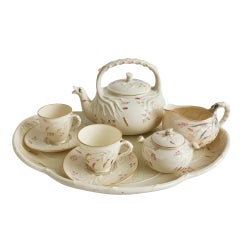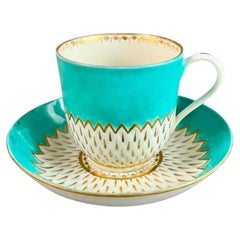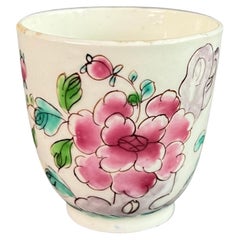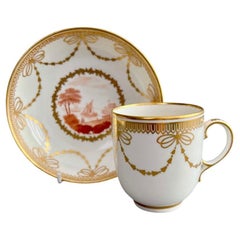Want more images or videos?
Request additional images or videos from the seller
1 of 13
Belleek Demitasse Cup and Saucer, Shamrock Pattern, 1926-1946
Price:$140
About the Item
- Creator:Belleek Pottery Ltd. (Maker)
- Dimensions:Height: 1 in (2.54 cm)Width: 1 in (2.54 cm)Depth: 1 in (2.54 cm)
- Sold As:Set of 2
- Style:Arts and Crafts (In the Style Of)
- Materials and Techniques:
- Place of Origin:
- Period:
- Date of Manufacture:1926-1946
- Condition:Wear consistent with age and use. The set is in perfect antique condition without any damage, repairs, crazing or significant wear.
- Seller Location:London, GB
- Reference Number:Seller: A-BEL10g1stDibs: LU4805128550742
About the Seller
5.0
Vetted Professional Seller
Every seller passes strict standards for authenticity and reliability
Established in 2016
1stDibs seller since 2019
227 sales on 1stDibs
Typical response time: 1 hour
Authenticity Guarantee
In the unlikely event there’s an issue with an item’s authenticity, contact us within 1 year for a full refund. DetailsMoney-Back Guarantee
If your item is not as described, is damaged in transit, or does not arrive, contact us within 7 days for a full refund. Details24-Hour Cancellation
You have a 24-hour grace period in which to reconsider your purchase, with no questions asked.Vetted Professional Sellers
Our world-class sellers must adhere to strict standards for service and quality, maintaining the integrity of our listings.Price-Match Guarantee
If you find that a seller listed the same item for a lower price elsewhere, we’ll match it.Trusted Global Delivery
Our best-in-class carrier network provides specialized shipping options worldwide, including custom delivery.You May Also Like
Antique Fine Irish Belleek Porcelain Demitasse Cup and Saucer
By Belleek Pottery Ltd.
Located in Chula Vista, CA
Fine Irish Belleek Demitasse Cup and Saucer
basketweave shamrock eggshell antique porcelain
Saucer 4.5 Cup 2.5 x 2h
maker stamp present
hand painted
original estate preowned vintage ...
Category
Mid-20th Century Northern Irish Mid-Century Modern Porcelain
Materials
Porcelain
Spode Indian Tree Cup and Saucer
Located in Asheville, NC
This is an absolutely fabulous antique Copeland Spode Indian tree cup and saucer. It is a spectacular example of Spode porcelain with rust and orange...
Category
Antique 18th Century and Earlier English Porcelain
Materials
Porcelain
Royal Doulton White Blue Gold Coffee or Tea Demitasse Cup & Saucer, circa 19th C
By Davis Collamore & Co Ltd. 1, Royal Daulton
Located in New York, NY
A very special English Royal Doulton for luxury retailer Davis Collamore & Co LTD, espresso coffee or tea demitasse cup and saucer set, ci...
Category
Antique Late 19th Century English Tea Sets
Materials
Gold
$675
H 2.38 in Dm 4.5 in
White and Gilt Neoclassical Cupid Arrow Cup & Saucer
Located in New York, NY
White and gilt neoclassical cupid arrow cup & saucer. Empire period designed white and gilt porcelain Valentine cupid's arrows and floral sprays. Under-glaze marks for Vienna. Aust...
Category
Antique Early 19th Century Austrian Empire Porcelain
Materials
Porcelain
Antique Early 19th Century Spode Porcelain Pattern Number 2408 Tea Cup & Saucer
By Spode
Located in Philadelphia, PA
A fine antique Spode porcelain cup & saucer.
Pattern no. 2408
Decorated throughout with a cobalt floral patttern and extensive gilding.
Simply a great cup & saucer from Spod...
Category
Antique Early 19th Century English Neoclassical Porcelain
Materials
Porcelain
$295
H 2.63 in Dm 5.5 in
Antique Chinese Cup & Saucer, circa 1840
Located in New Orleans, LA
Antique Chinese cup & saucer, circa 1840.
Category
Antique Mid-19th Century Chinese Tea Sets
Materials
Porcelain
19th Century Meissen Hand Painted Cup and Saucer
By Meissen Porcelain
Located in Lambertville, NJ
Diminutive whimsical 19th century Meissen cup and saucer. The purple trim with gilt decoration with birds and insects. The saucer is 5 inches in...
Category
Antique 19th Century German Porcelain
Materials
Porcelain
Antique Italian Doccia Topographical Porcelain Neoclassical Cup and Saucer
By Doccia Porcelain
Located in Philadelphia, PA
A very fine antique Italian Doccia Topographical porcelain neoclassical cup & saucer.
By Doccia Porcelain Manufactory circa 1820.
With pa...
Category
Antique Early 19th Century Italian Neoclassical Porcelain
Materials
Porcelain
$1,650 / set
H 2.5 in Dm 5.25 in
Pair Green Pink and Gilt Grape Leaf and Rose Cups and Saucers
By Royal Crown Derby Porcelain
Located in New York, NY
Pair green pink and gilt grape leaf and rose cups and saucers. Pair antique Derby porcelain breakfast or tea sets in vibrant green and soft pink with gilt vin...
Category
Antique Early 19th Century English Tea Sets
Materials
Porcelain
$240 Sale Price / set
20% Off
H 2.25 in Dm 3.38 in
Thomas Wolfe Factory Z Lion Pattern English Teacup and Saucer
Located in Bishop's Stortford, Hertfordshire
A scarce antique English Staffordshire bone china teacup and saucer hand decorated with a red lion by Thomas Wolfe (Factory Z) and dating from...
Category
Antique 1810s English George III Tea Sets
Materials
Porcelain
More From This Seller
View AllBelleek Cabaret Tea Set for Two, Cream Grass Pattern, Victorian 1863-1891
By Belleek Pottery Ltd.
Located in London, GB
This is a beautiful and very rare Belleek cabaret set in the Grass design, consisting of a teapot, two teacups and saucers, a milk jug and a lidded sugar bowl, all placed on a large tray. All items carry the 1st Black Mark, which was used between 1863 and 1891.
It is extremely rare to come across an entire cabaret set of these antique items, particularly when in such fabulous condition, so this is a rare opportunity!
If you ever thought Belleek fine china looks, sounds and feels unique, you are right. There is a back story to this extraordinarily fine Irish eggshell porcelain, which has an unusually high amount of "frit" and therefore is thinner and finer than any other china.
Pottery in Belleek (in the now Northern-Irish area of Fermanagh) had started in 1849 with John Caldwell Bloomfield, who was a wealthy land owner. During the Irish famine...
Category
Antique Late 19th Century Northern Irish Victorian Tea Sets
Materials
Porcelain
Derby Porcelain Coffee Cup, Artichoke Pattern in Turquoise, Georgian ca 1785
By Derby
Located in London, GB
This is a beautiful coffee cup and saucer made by Derby in about 1785. The set has the distinctive "artichoke" moulding and a bright turquoise ground with the white artichoke surface...
Category
Antique 1780s English George III Tea Sets
Materials
Porcelain
Bow Porcelain Orphaned Coffee Cup, Famille Rose Peony, circa 1755
By Bow Porcelain
Located in London, GB
This is a very charming orphaned coffee cup made by the Bow Porcelain factory in about 1755. The cup is decorated in a Chinese "famille rose" peony pattern. This cup would have been part of a large tea service, and the tiny size shows how expensive coffee was in the 18th Century.
The Bow Porcelain Factory was one of the first potteries in Britain to make soft paste porcelain, and most probably the very first to use bone ash, which later got perfected by Josiah Spode to what is now the universally used "bone china". Bow was the main competitor of the Chelsea Porcelain Factory, but where Chelsea made very fine slipcast porcelain, Bow made a different soft paste porcelain that tended to be softer and could be pressed into moulds. Bow served a larger public generally at lower prices. The factory was only in operation between 1743 and 1774, after which the tradition got incorporated into some of the later famous potteries such as Worcester and Derby.
The cup is unmarked, which is normal for Bow items of this era.
Condition report the cup is in excellent condition without any damage or repairs. There are various glazing imperfections, which are quite normal for porcelain of this era.
Antique British porcelain...
Category
Antique 1750s English Rococo Tea Sets
Materials
Porcelain
Derby Coffee Cup, Monochrome Sepia Landscapes Zachariah Boreman, ca 1785
By Crown Derby, Derby
Located in London, GB
This is a very rare and stunning coffee cup and saucer made by Derby in about 1785. The set has a white ground with graceful gilding, and two stunning little landscapes painted by Za...
Category
Antique 1780s English Romantic Tea Sets
Materials
Porcelain
Chelsea-Derby Chocolate Cup Set, Gilt Stripes, Puce Flowers, Rococo 1770-1775
By Derby, Chelsea-Derby, Chelsea Porcelain
Located in London, GB
This is a beautiful chocolate cup set made by Chelsea-Derby between 1770 and 1775, which was the Rococo era. The set consists of a cup, a saucer and a cover, and is decorated in a st...
Category
Antique 1770s English Rococo Tea Sets
Materials
Porcelain
$1,175 / set
Free Shipping
H&R Daniel Coffee Cup Duo, Plain Shape, White with Landscape, 1825-1830
By H&R Daniel
Located in London, GB
This is an extremely rare and beautiful coffee cup and saucer made by H&R Daniel some time between 1825 and 1830. The set is potted in the "plain" shape and bears pattern no. 4652 wi...
Category
Antique 1820s English Rococo Revival Tea Sets
Materials
Porcelain
Recently Viewed
View AllMore Ways To Browse
Antique Hand Painted Tea Cups
Porcelain Demitasse Set
Antique Demitasse Sets
Antique Eggshell Porcelain
Irish Shamrock
Antique Belleek Pottery Ireland
Belleek Hand Painted
Irish Silver Tea Set
Irish Tea Set
Belleek China
Belleek Pottery Ltd. On Sale
Belleek Tea Cup And Saucer
Belleek Tea Set
Shamrock Belleek
Gold Teapot
Imari Tea Set
Victorian Teapot
Antique Chocolate Pots



